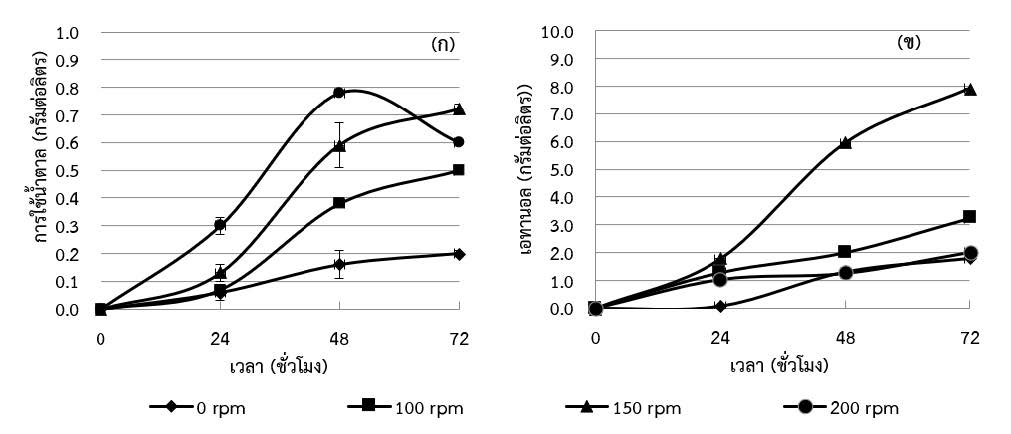สภาวะที่เหมาะสมต่อผลิตเอทานอลจากกากกาแฟ โดย Saccharomyces cerevisiae
คำสำคัญ:
กากกาแฟ, เอทานอล, ลิกโนเซลลูโลส, Saccharomyces cerevisiaeบทคัดย่อ
กากกาแฟเป็นวัสดุเศษเหลือที่เกิดจากกระบวนการชงกาแฟผงด้วยน้ำร้อนหรือไอน้ำ เป็นของเสียที่ได้จากการเตรียมกาแฟสำเร็จรูป ซึ่งกากกาแฟที่เกิดขึ้นส่วนใหญ่นี้ถูกนำไปทิ้ง โดยไม่มีการนำมาใช้ให้เกิดประโยชน์ ดังนั้นงานวิจัยนี้จึงมีวัตถุประสงค์เพื่อศึกษาวิธีการปรับสภาพกากกาแฟและหาสภาวะที่เหมาะสมสำหรับการผลิตเอทานอล จากการศึกษาพบว่ากากกาแฟมีองค์ประกอบของเซลลูโลสร้อยละ 41.78±4.66 เฮมิเซลลูโลสร้อยละ 28.02±3.38 ลิกนินร้อยละ 29.10±0.92 และเถ้าร้อยละ 1.10±0.01 โดยน้ำหนักแห้ง นำกากกาแฟมาปรับสภาพด้วยวิธีการทางเคมีร่วมกับความร้อน และย่อยด้วยเอนไซม์เซลลูเลสความเข้มข้น 13 ยูนิต พบว่าการปรับสภาพด้วยกรดซัลฟิวริกความเข้มข้นร้อยละ 1 ที่อุณหภูมิ 90 องศาเซลเซียส เป็นเวลา 30 นาที และย่อยด้วยเอนไซม์เซลลูเลส ให้ปริมาณน้ำตาลรีดิวซ์สูงสุดเท่ากับ 3.564±0.234 กรัมต่อลิตร จากนั้นนำกากกาแฟที่ผ่านการปรับสภาพแล้วมาใช้เป็นสารตั้งต้นในการผลิตเอทานอลโดย Saccharomyces cerevisiae พบว่าสภาวะที่เหมาะสมต่อการผลิตเอทานอลคือ การใช้แอมโมเนียมฟอสเฟตเป็นแหล่งไนโตรเจน อุณหภูมิที่เหมาะสมคือ 28 องศาเซลเซียส และให้อัตราการเขย่าที่ 150 รอบต่อนาที เป็นเวลา 72 ชั่วโมง โดยให้การผลิตเอทานอล อัตราการใช้สารตั้งต้น และอัตราการผลิตเท่ากับ 7.92±0.02 กรัมต่อลิตร, 0.01±0.001 กรัมต่อลิตรต่อชั่วโมง และ 0.11±0.001 กรัมต่อลิตรต่อชั่วโมง ตามลำดับ ดังนั้นกากกาแฟสามารถที่จะนำมาใช้ประโยชน์ในการผลิตเอทานอลเพื่อเป็นแหล่งพลังงานทางเลือกในอนาคตได้
เอกสารอ้างอิง
กนกรัตน์ ใสสอาด, เบญจมาศ หนูแป้น และกิตติมา คงทน. (2560). การผลิตเอทานอลจากเส้นใยเปลือกผลจากโดย Saccharomyces cerevisiae. รายงานวิจัย สาขาวิชาชีววิทยา คณะวิทยาศาสตร์และเทคโนโลยี มหาวิทยาลัยราชภัฏสุราษฎร์ธานี.
นันทิกา คล้ายชม, เพ็ญจิตร ศรีนพคุณ และอนุสิษฐ์ ธนะพิมพ์เมธา. (2554). การผลิตน้ำตาลรีดิวซ์จากซังข้างฟางหวานโดยกระบวนการไฮโดรไลซิสด้วยกรด. วิศวกรรมสาร มก. 24(75):น. 91-102.
รพีพรรณ กองตูม. (2560). กากกาแฟ: มูลค่าเพิ่มและการใช้ประโยชน์. ในการประชุมวิชาการระดับชาติ ราชภัฏหมู่บ้านจอมบึงวิจัย ครั้งที่ 5 (น. 362). ราชบุรี.
วนิดา ปานอุทัย, นิคม แหลมสัก, สาโรจน์ ศิริศันสนียกุล, วิรัตน์ วาณิชย์ศรีรัตร และประมุข ภระกูลสุขสถิตย์. (2553). การผลิตเอทานอลจากไม้ยูคาลิปตัสโดยกระบวนการย่อยเป็นน้ำตาลและหมักพร้อมกัน. ในการประชุมทางวิชาการของมหาวิทยาลัยเกษตรศาสตร์ ครั้งที่ 48 (น. 392). กรุงเทพ: สาขาอุตสาหกรรมเกษตร.
สาวิตรี ลิ่มทอง. (2549). ยีสต์: ความหลากหลายทางเทคโนโลยีชีวภาพ. กรุงเทพฯ: มหาวิทยาลัยเกษตรศาสตร์.
Arrizon, J. and Gschaedler. A. (2002). Increasing fermentation efficiency at high sugar concentrations by supplementing an additional source of nitrogen during the exponential phase of the tequila fermentation process. Canadian Journal Microbiology, 48(11), pp. 965-970.
Association of official analytical chemists. (1999). Official methods of analysis. The Association, D.C. Washington.
Ballesteros, L.F., Teixeira, J.A. and Mussatto, S.I. (2014). Chemical, Functional, and Structural Properties of Spent Coffee Grounds and Coffee Silverskin. Food Bioprocess Technology, 7, pp. 3493–3503.
Banat, I.M., Nigam, P., Singh, D., Marchant, R. and McHale, A.P. (1998). Review: Ethanol production at elevated temperatures and alcohol concentrations: Part I: Yeasts in general. World Journal of Microbiology and Biotechnology, 14, pp. 809-821.
Battista, F., Barampouti, E.M., Mai, S., Bolzonella, D., Malamis, D., Moustakas, K. and Loizidou, M. (2020). Added-value molecules recovery and biofuels production from spent coffee grounds. Renewable and Sustainable Energy Reviews, 131, 110007. https://doi.org/10.1016/j.rser.2020.110007
Bomfim, A.S.C., Oliveira, D.M., Walling, E., Babin, A., Hersant, G., Vaneeckhaute, C., Dumont, M.J. and Rodrigue, D. (2023). Spent Coffee Grounds Characterization and Reuse in Composting and Soil Amendment. Waste, 1, pp. 2-20. https://doi.org/10.3390/waste1010002.
Boudrahem, F., Soualah, A. and Aissani-Benissad, F. (2011). Pb(II) and Cd(II) removal from aqueous solutions using activated carbon developed from coffee residue activated with phosphoric acid and zinc chloride. Journal of Chemical & Engineeing Data, 56(5), pp. 1946-1955.
Chhandama, M.V.L., Satyan, K.B., Changmai, B., Vanlalveni, C. and Rokhum, S.L. (2021). Microalgae as a feedstock for the production of biodiesel: a review. Bioresource Technology Report, 15, http://doi.org/10.1016/j.biteb.2021.100771.
Jutakanoke, R., Leepipatpiboon, N., Tolieng, V., Kitpreechavanich, V., Srinorakutara, T. and Akaracharanya, A. (2012). Sugarcane leaves: Pretreatment and ethanol fermentation by Saccharomyces cerevisiae. Biomass and Bioenergy, 39, pp. 283-289.
Khenniche, L. and Benissad-Aissani, F. (2010). Adsorptive removal of phenol by coffee residue activated carbon and commercial activated carbon: equilibrium, kinetics, and thermodynamics. Journal of Chemical & Engineering Data, 55(11), pp. 4677-4686.
Kittiratmai, P. (2003). Improvement of ethanol fermentation efficiency by flocculent yeast and repeated fedbatch. (Masters thesis, Kasetsart University, Thailand.)
Kovalcik, A., Obruca, S. and Marova, I. (2018). Valorization of spent coffee grounds: A review. Food and Bioproducts Processing, 110, pp. 104–119.
Kwon, E.E., Yi, H., and Jeon, Y.J. (2013). Sequential co-production of biodiesel and bioethanol with spent coffee grounds. Bioresource Technology, 136, pp. 475–480.
Lucero, P., Penalver, E., Moreno, E. and Lagunas, R. (2000). Internal trehalose protects endocytosis from inhibition by ethanol in Saccharomyces cerevisiae. Applied Environmental Microbiology, 66(10), pp. 4456-4461.
Manivannan, A., Jayarani, P.H. and Narendhirakannan, R.T. (2012). Enhanced acid hydrolysis for bioethanol production from water hyacinth (Eichhornia crassipes) using fermenting yeast Candida intermedia NRRL Y-981. Journal of Scientific and Industrial Research, 71(1), pp. 51-56.
Mas, A., Torija, M.J., Garcia-Parrilla, M.C. and Troncoso A. (2014). Acetic acid bacteria and the production and quality of wine vinegar. The Science World Journal, 39, pp. 46-57.
Mussatto, S.I., Carneiro, L.M., Silva, J.P.A., Roberto, I.C. and Teixeira, J.A. (2011). A study on chemical constituents and sugars extraction from spent coffee grounds. Carbohydrate Polymers, 83(2), pp. 368-374.
Nuanpeng, S., Thanonkeo, S., Yamada, M. and Thanonkeo, P. (2016). Ethanol production from sweet sorghum juice at high temperature using a newly isolated thermotolerant yeast Saccharomyces cerevisiae DBKKU Y-53. Energies, 9, pp. 253.
Sun, Y. and Cheng, J. (2002). Hydrolysis of linocellulosic material for ethanol production: a review. Bioresource Technology, 83(1), pp. 1-11.
Torija, M.J., Beltran, G., Novo, M., Poblet, M., Guillamon, J.M., Mas, A. and Rozes, N. (2003). Effects of fermentation temperature nd Saccharomyces species on the cell fatty acid composition and presence of volatile compounds in wine. International Journal of Food Microbiology, 85, pp. 127-136.
Torija, M.J., Beltran, G., Novo, M., Poblet, M., Rozes, N., Mas, A. and Guillamoan J.M. (2003). Effect of organic acids and nitrogen source on alcoholic fermentation: Study of their buffering capacity. Journal of Agricultural and Food Chemistry, 51(4), pp. 916-922.
Wong, Y.Y., Rawindran, H., Lim, J. W., Tiong, Z. W., Liew, C. S., Lam, M. K., Kiatkittipong, W., Abdelfattah, E. A., Oh, W. D. and Ho, Y. C. (2022). Attached microalgae converting spent coffee ground into lipid for biodiesel production and sequestering atmospheric CO2 simultaneously. Algal Research, 66, http://doi.org/10.1016/j.algal.2022.102780.
Zhang, J., Zhou, H., Liu, D. and Zhao, X. (2020). Chapter 2 – Pretreatment of lignocellulosic biomass for efficient enzymatic saccharification of cellulose. in book Lignocellulosic Biomass to Liquid Biofuels (pp. 17-65). Academic Press. https://doi.org/10.1016/C2017-0-03529-2.

ดาวน์โหลด
เผยแพร่แล้ว
รูปแบบการอ้างอิง
ฉบับ
ประเภทบทความ
สัญญาอนุญาต
ลิขสิทธิ์ (c) 2023 วารสารวิจัย วิทยาศาสตร์และเทคโนโลยี มหาวิทยาลัยราชภัฏนครราชสีมา

อนุญาตภายใต้เงื่อนไข Creative Commons Attribution-NonCommercial-NoDerivatives 4.0 International License.
เนื้อหาและข้อมูลในบทความที่ลงตีพิมพ์ในวารสารวิจัย วิทยาศาสตร์และเทคโนโลยี มหาวิทยาลัยราชภัฏนครราชสีมา ถือเป็นข้อคิดเห็นและความรับผิดชอบของผู้เขียนบทความโดยตรงซึ่งกองบรรณาธิการวารสาร ไม่จำเป็นต้องเห็นด้วย หรือร่วมรับผิดชอบใด ๆ
บทความ ข้อมูล เนื้อหา รูปภาพ ฯลฯ ที่ได้รับการตีพิมพ์ในวารสารวิจัย วิทยาศาสตร์และเทคโนโลยี มหาวิทยาลัยราชภัฏนครราชสีมา ถือเป็นลิขสิทธิ์ของวารสารวิจัย วิทยาศาสตร์และเทคโนโลยี มหาวิทยาลัยราชภัฏนครราชสีมา หากบุคคลหรือหน่วยงานใดต้องการนำทั้งหมดหรือส่วนหนึ่งส่วนใดไปเผยแพร่ต่อหรือเพื่อกระทำการใด ๆ จะต้องได้รับอนุญาตเป็นลายลักอักษรจากวารสารวิจัย วิทยาศาสตร์และเทคโนโลยี มหาวิทยาลัยราชภัฏนครราชสีมา ก่อนเท่านั้น


